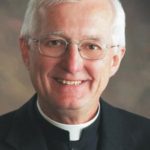
A California mother’s face conveys the profound grief she is experiencing after the loss of her 6-year-old son, a shooting victim caught in the crossfire of a road rage incident as she drove him to school. Closer to home, Davenport’s police chief, mayor and other civic leaders held a news conference June 7, pleading for the community to help stop gun violence plaguing the city. Their public appeal was in response to a downtown melee that led to gunfire damaging the Figge Art Museum and the Skybridge. This time, no one died. What about next time?
June is Gun Violence Awareness Month. The Centers for Disease Control and Prevention (CDC) identify firearm violence as a “serious public health problem in the United States that impacts the health and safety of Americans.” The CDC acknowledges that gaps remain in the agency’s knowledge about this pervasive problem and ways to prevent it. We must address those gaps to keep “individuals, families, schools, and communities safe from firearm violence and its consequences.”
Before we identify the four steps to the CDC’s public health approach to gun violence, we need to acknowledge its prevalence in our society. The CDC reports 39,707 firearm-related deaths in the United States in 2019, or roughly 109 people dying from a firearm-related injury each day. Six out of every 10 deaths were firearm suicides and more than three out of every 10 were firearm homicides. Gun violence happens in our diocese; the daily newspaper and social media accounts provide proof.
The CDC reports that rates of firearm violence vary by age and race/ethnicity. Firearm homicide rates are highest among teens and young adults 15-34 years of age, and among Black, American Indian/Alaskan Native, and Hispanic populations. Firearm suicide rates are highest among adults 75 years of age and older and among American Indian/Alaskan Native and non-Hispanic white populations.
Many more gunfire victims do not die but suffer the consequences of their injuries, including 14-year-old Zach Smith, a member of Our Lady of Lourdes Parish in Bettendorf. He was a victim of errant gunfire as he rode in his dad’s car through a Davenport intersection May 22. The CDC reports that people who survive a firearm-related injury may experience long-term consequences ranging from physical to emotional and mental health issues.
A group called Davenport Bearing Witness held a prayer service May 26 at the intersection where Zach was shot, praying for victims and perpetrators of gun violence. Group representative John De Taeye said the issue of gun violence goes beyond public safety and health. It is a spiritual issue. Yes, it is a spiritual issue, which requires both a public health approach and spiritual approach.
We begin with prayer, daily, for victims and perpetrators of gun violence. We participate in or support the efforts of organizations like Davenport Bearing Witness (davenportbearingwitness@gmail.com) and our local communities. Davenport Mayor Mike Matson, for example, has established a Community Task Force that will meet June 14.
A pastor who participated in the prayer service said we must put more effort into getting to the root problem of the violence. That’s where the hard, methodical, patient work begins.
The CDC identifies these four steps:
1) Define and monitor the problem. The first step in preventing violence is to understand the “who,” “what,” “when,” “where,” and “how” associated with it. Grasping the magnitude of the problem involves analyzing data such as the number of violence-related behaviors, injuries, and deaths.
2) Identify risk and protective factors. It is important to understand what factors protect people or put them at risk for experiencing or perpetrating violence. Risk factors do not cause violence. The presence of a risk factor does not mean that a person will always experience violence. Victims are never responsible for the harm inflicted upon them.
3) Develop and test prevention strategies. Findings from the research literature and data from needs assessments, community surveys, stakeholder interviews, and focus groups are useful for designing prevention strategies.
4) Assure widespread adoption. Communities are encouraged to implement strategies based on the best available evidence and to assess continuously whether the strategy is a good fit with the community context and achieving its goal of preventing violence.
Our church teaches that all of us have been created in the image and likeness of God. We are committed to protecting life from conception until natural death as a basic requirement of a just and moral society.
Barb Arland-Fye, Editor
Arland-fye@davenportdiocese.org











